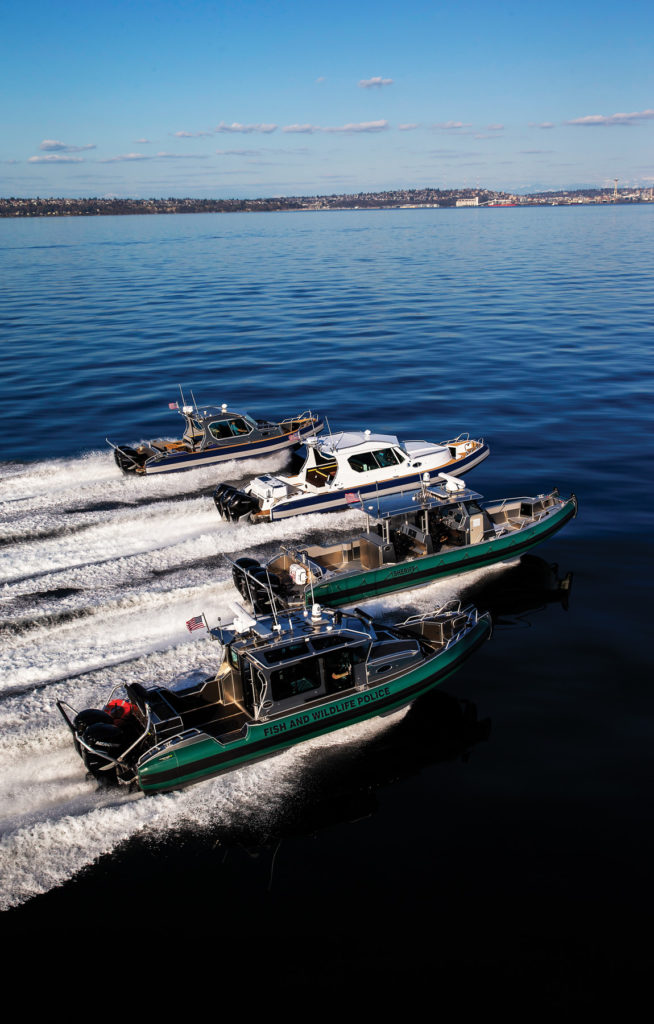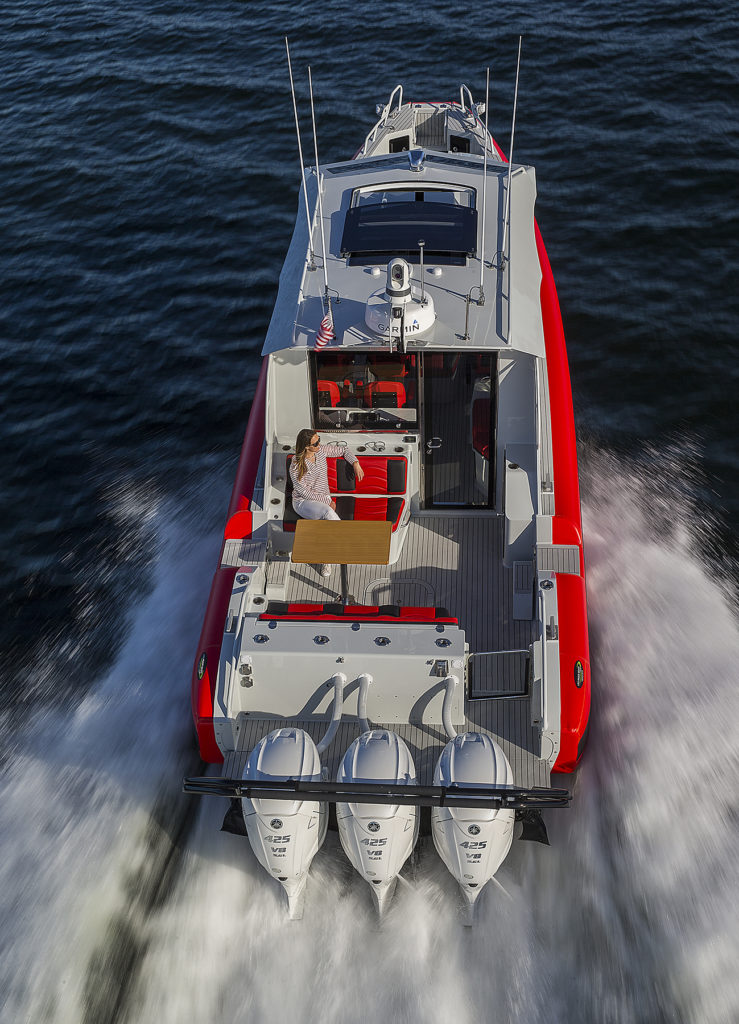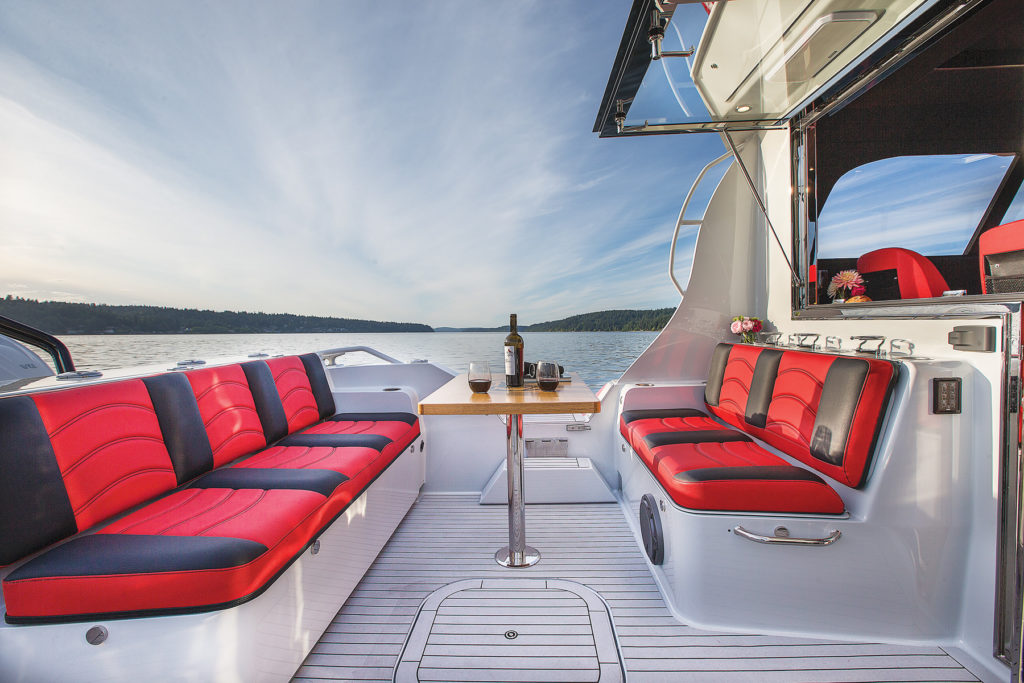
It’s an almost universal rule in the boating world: Speed sells. And few boat builders in the Pacific Northwest have combined durability, flexibility, and pure speed quite as well as Life Proof Boats,based in Bremerton, Washington. All around the Salish Sea, Life Proof’s product lines of aluminum tenders, sportfishing boats, and runabouts, as well as commercial watercraft for police and fire departments, have multiplied rapidly since the company was first established in 2014.
Do they ever churn rapidly through those waters, too. “Most of our clients are very comfortable with speeds of about 50 miles per hour,” says Life Proof CEO Micah Bowers, with a chuckle. Top speeds, however, can often be well north of 60 mph, depending on the engine package.
In more recent years, the boats themselves have evolved about as fast as their speeds. Starting with a few lines of sturdy, nimble 17’ to 25’ center-console tenders with single or double outboards, Life Proof now offers triple-engine models from 27’ to 41’, complete with closed cabins, galleys with sleek wrap-around benches and dining tables, stand-up heads, and berths for up to three people. Perhaps the corollary to “speed sells” is “size matters.”
“We found that customers want bigger boats,” Bowers said. Just last month, the company showcased 35’ and 41’ models at Seattle’s Boats Afloat show. Each of these models—with beams of 11’ and 12’ respectively—feature a lower cuddy with its own head, plus two bonus sleepers under the settee and in the saloon.
Even with increasingly comfortable amenities, Life Proof boats of all sizes have never skimped on performance. The 35s can achieve speeds in excess of 55 mph from their triple 425-hp outboards and can turn on a dime with full control, thanks to custom-designed interceptor strakes and forward performance fins. Nearly all models are also equipped with Shockwave suspension, S5 helm chairs to manage the chop at high speeds. On the 41-footers, a triple set of V12 600-hp Mercury Verados are the newest outboard engines in the West Coast market, Bowers boasted.
Still, the latest and largest model at Life Proof is yet to come. Spring 2022 is the expected release date for the new 50’ model, featuring a triple set of the beefy Mercury 600s or a quad set of 425s. With a 14’ beam, the new boat will have room for a bow cockpit, a rear BBQ area, and three separate sleeping locations, plus a large master berth.

Safety First
While it’s generally taboo to say a boat can never go under, regardless of size, Life Proof pushes the idea, calling their boats “virtually unsinkable.” A bold claim? Perhaps. But each boat backs it up with what might be their most recognizable feature—a foam-filled collar encircling the gunwales.
Though the collar systems may look inflatable, they are made of a rigid, expanded polyethylene foam, covered in tough urethane or PVC material. The closed-cell foam within the rings is impervious to water and provides more than 60 pounds of flotation per cubic foot. Even if the boat is swamped, the self-bailing scuppers can remove all the water in less than a minute.
Because of these collars, the all-aluminum boats are often confusingly categorized as RIBs. “They act very similar to a traditional RIB, in terms of the added stability,” Bowers explained. But since they never deflate, he added, the collars provide “all of the best parts” of RIBS “without any of the bad ones.”

Custom Crafted
Owned by the marine industry innovation company Inventech Marine Solutions (inventechmarine.com), Life Proof has also become known for its wide array of customized boat options. Much of that variety comes from the company’s reliance on aluminum hulls. With 40,000 square feet of manufacturing space across three facilities in Bremerton, Life Proof does all their own aluminum cutting and welding. The team works exclusively with 5086 H32 grade aluminum, cutting metal sheets with a CNC router to any precise configuration.
For the first few years, Life Proof Boats had a general look of rugged, utilitarian tenders, but nearly every one of them looked a little different. “Customers would ask, ‘Can you build this?’ and we almost always could,” Bowers said. One 31’ GT Coupe model, in fact, includes an open-air jacuzzi in the bow section, as requested by the client. The water is kept hot via heat exchangers in the twin 200hp OXE diesel engines.
As the company matured, Life Proof began making fewer customizations and focused on developing existing brands. That’s not to say the number of boat lines is shrinking. Currently, there are ten models of pleasure craft—including its best-selling 23’ to 27’ Runabout series—five in the “yacht-class” tender market, and another ten for commercial uses. Due to the speed and maneuverability of the models, as well as the handy folding bow doors and reinforced beaching plates, police and other government entities account for about 40% of Life Proof’s sales.
“We first became popular largely through word-of-mouth in the Pacific Northwest,” Bowers said. But over its seven years of business, the company has expanded its reach to Hawaii, California, and Florida, and also has a sales center in Canada. Some of their custom-made boats have even made it all the way to Guam and Saipan.
Like virtually all businesses around the country, Life Proof has suffered delays in getting access to materials because of the COVID-19 pandemic. Sales have been brisk, but delivery times after each order have stretched to two and a half to three years. “The biggest bottleneck is getting computer chips for the Mercury engines to keep up with the demand,” Bowers said.
But as the world hopes to emerge from the ongoing COVID-19 crisis in the next year, Life Proof aims to prove it can remain a reliable source of practical, durable, and, above all, fun watercraft in the Northwest.
>> For more information on Life Proof Boats visit: lifeproofboats.com.